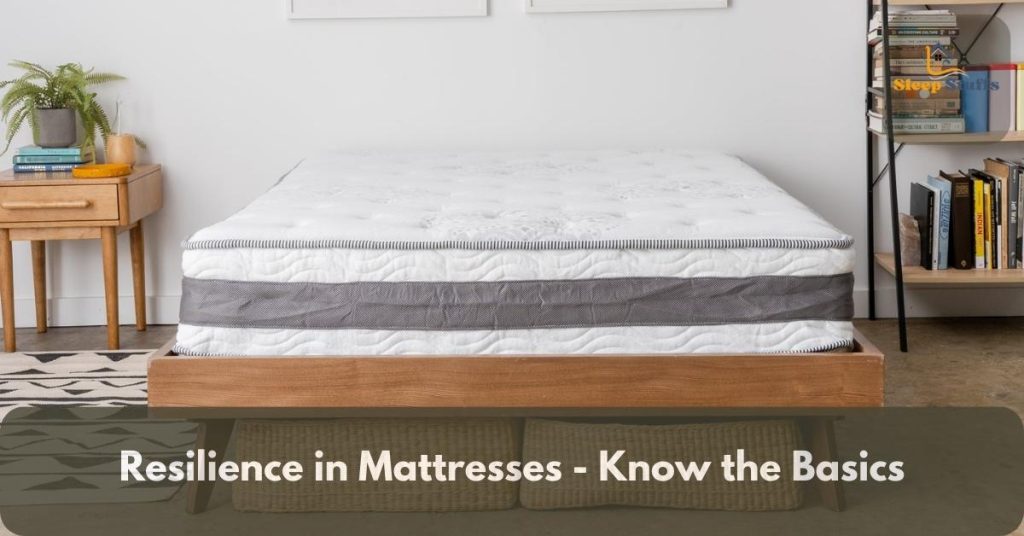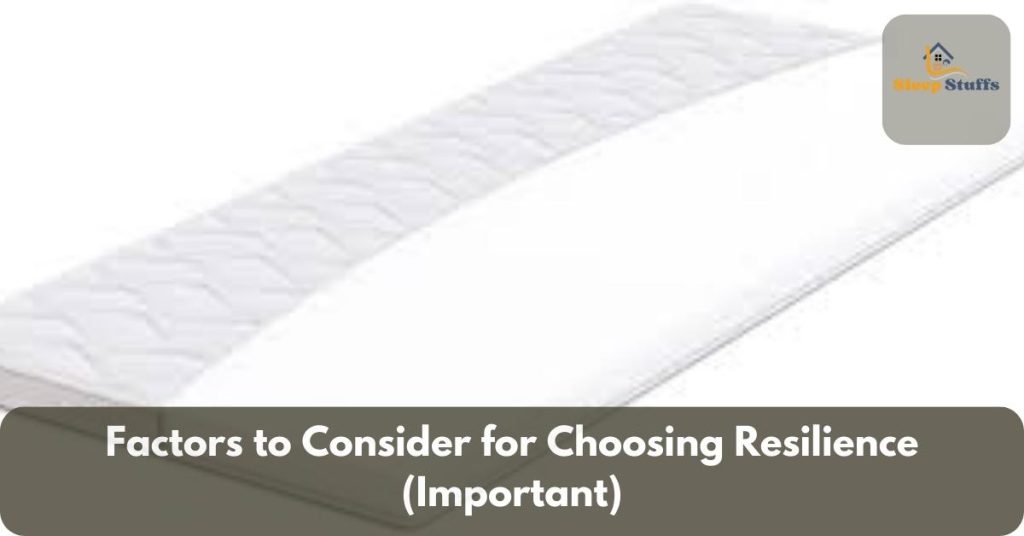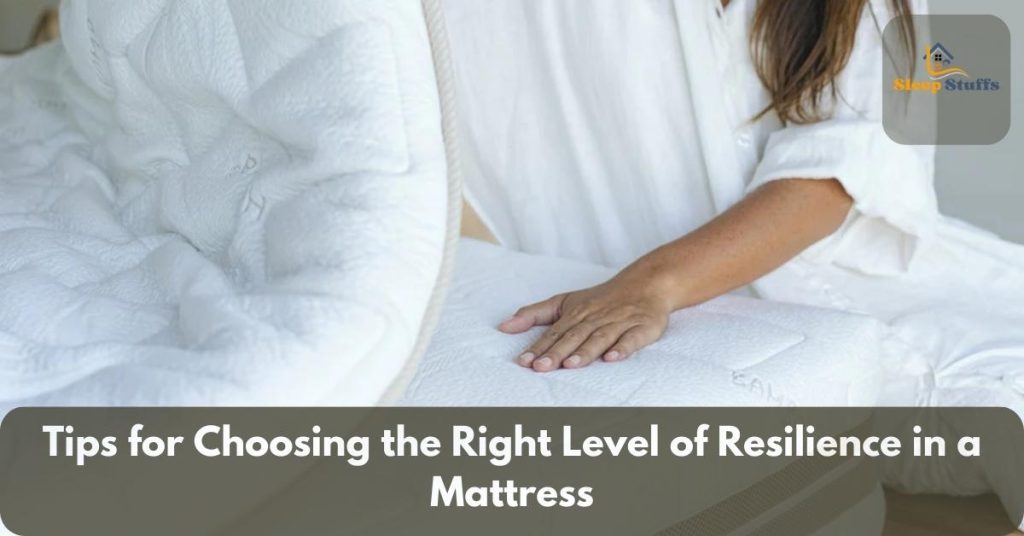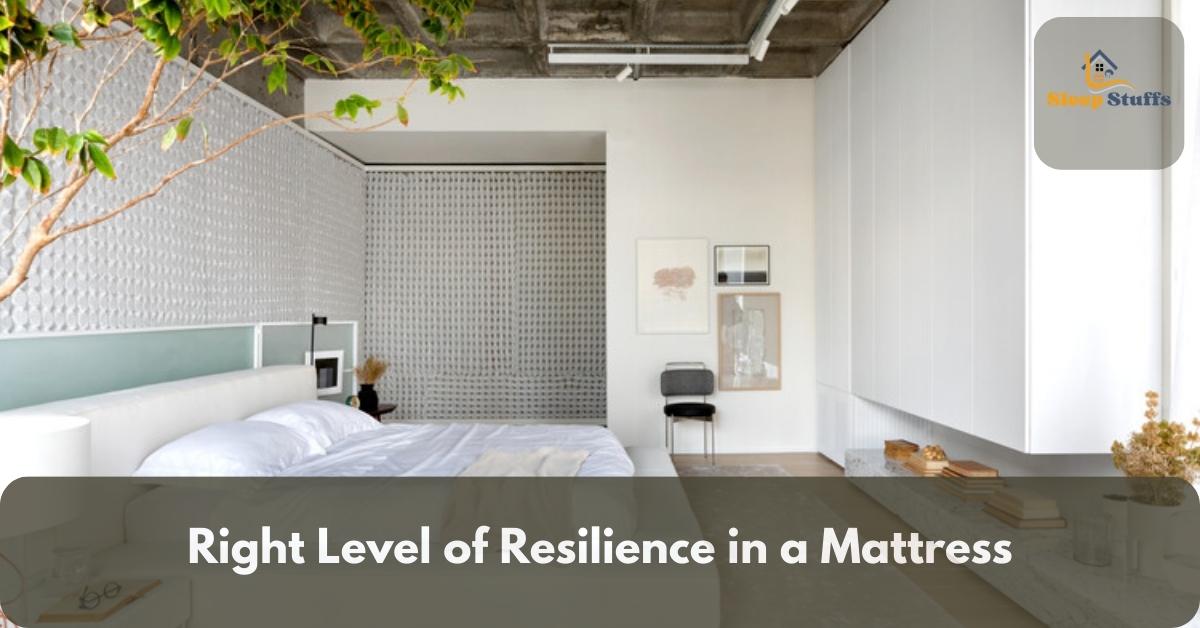When looking for a new bed, Choosing the Right Level of Resilience in a Mattress is essential. It would be best to do this to get a good night’s sleep. How well the mattress responds to your weight and shape depends on its resilience. It also gives good support and is comfortable.
This post will tell you everything you need to know about how hard a mattress is. You may be certain that your requirements will be met.
Please do what we say to learn more about how well the mattress holds up.
Let’s get started!
So, I’ve decided to talk about mattress resilience – the fundamentals.
Resilience in Mattresses – Know the Basics

Before we get to the ideas, it’s essential to know what “resilience” means regarding beds. How a mattress responds to pressure when pressed down reveals its strength. It will come after that has changed the following facts.
- Comfort,
- Support, And
- Durability Of The Mattress.
Different individuals have varying preferences. But, when it comes to resilience, depending on factors such as –
- Body Weight,
- Sleeping Position, And
- Personal Comfort Levels.
I will now talk about Choice Factors for Resilience.
Factors to Consider for Choosing Resilience (Important)

You need to think about a few things to choose the right amount of grit and ensure comfort and support.
Let’s explore the essential aspects you should keep in mind when making your decision.
Body Weight
Body weight plays a significant role in determining the right level of Durability and resilience. Heavier individuals may prefer a mattress with higher stability. It is to provide adequate support and prevent sinking too deeply. Besides, lighter individuals may find beds with lower resilience more comfortable. Sometimes they offer more contouring and cushioning.
Sleeping Position
Your preferred sleeping position is another crucial factor. Support and pressure relief needs vary depending on the sleeping position.
For example:
Side sleepers
They generally enjoy a mattress with medium to high resilience. It will support the shoulders and hips while maintaining spinal alignment.
Back sleepers
They prefer a medium level of resilience. This provides proper support for the lower back and maintains neutral alignment.
Stomach sleepers
They might need a more intricate cushion with less give to keep their stomachs from sinking too much.
Personal Comfort Preferences
When it comes to bed comfort, everyone has their own particular needs. Some individuals may enjoy being “hugged” by the mattress.
In the same way, others prefer a more responsive and buoyant surface.
Consider your personal preferences for firmness and the level of contouring you desire.
Motion Isolation
If you share your bed with a partner or tend to toss. As you may turn during the night, you want to consider a mattress with good motion isolation. Mattresses with higher resilience often excel in this area.
But they absorb and lessen motion transfer. It allows you and your partner to sleep undisturbed.
Temperature Regulation
Certain mattress materials and constructions affect temperature regulation. If you sleep hot, find a mattress that breathes well and keeps you cool.
Most of the time, movement and heat absorption are better on high-resilience beds. It is especially true for those with rubber or gel-infused foam.
Durability and Longevity
Investing in a mattress is a long-term decision. It’s essential to consider its durability and longevity. Mattresses with higher resilience often have better longevity because they are less likely to sag or get dented.
Remember this factor, especially if you’re looking for a mattress that will last for years.
Here I will go over several things to consider when selecting the firmness of your mattress.
Tips: Best Choosing the Right Level of Resilience in a Mattress

Now that we’ve discussed the essentials, let’s look at some tips to help you make an intelligent choice.
This will help you choose the level of resilience of your mattress.
Test Mattresses In Person
When looking for a mattress, it’s best to go to a store and try a few different ones. Lie on the bed for a few minutes in your preferred sleeping position. It will help to establish a sense of comfort and support. This hands-on experience can provide valuable insights. This also enables you to narrow down your options.
Consult Online Reviews and Recommendations
While trying mattresses in person, online reviews can also offer valuable information. Read reviews from reputable sources and consider what other people with similar tastes have said.
Look for reviews about how firm the beds you’re interested in are.
Seek Expert Advice
Talking to sleep experts or people who sell mattresses can help you choose the right amount of firmness.
These professionals can assess your specific needs. As well as recommend mattresses that align with your preferences and requirements.
Consider Dual-Sided Mattresses
If you and your partner have different ideas about how firm a mattress should be. Then, consider looking into two-sided beds.
These mattresses feature different levels of resilience on each side. It allows you to customize your sleeping experience. As well as accommodating both of your needs.
Look for Trial Periods and Warranties
Choose beds with trial periods so you have enough time to try it out in the comfort of your own home. Many manufacturers offer trial periods ranging from 30 to 100 nights. It allows you to assess their resilience and comfort before deciding.
Additionally, check the warranty coverage for any defects or issues that may arise.
Test for Motion Isolation
If you share a bed with a partner, consider bringing them along when testing mattresses. Check how well it blocks out motion by having your partner move or change places while lying down.
This test will help determine if the mattress minimizes motion transfer.
FAQs about Choosing the Right Level of Resilience
Here are some frequently asked questions and their answers about choosing the right amount of firmness in a mattress:
What is the best level of resilience for side sleepers?
Side sleepers generally enjoy mattresses with medium to high resilience. This level of stability offers enough support for the shoulders. As well as giving hips while contouring the body’s natural curves.
Are memory foam mattresses suitable for individuals with higher body weights
Yes, memory foam mattresses can suit individuals with higher body weights. Yet, it’s crucial to select a bed with higher-density foam. Thus, enhanced support is needed to prevent excessive sinking and maintain proper alignment.
How can I determine the resilience level of a mattress
The best way to determine the resilience level is by testing the mattress in person. Lie down in your preferred sleeping position. After that, observe how the mattress responds to your weight and movements. A mattress with higher resilience will regain its shape after pressure is applied.
Can the level of resilience affect back pain
Yes, the level of resilience can affect back pain. A mattress that doesn’t provide enough support or is too hard. This can cause back pain or worsen it if you already have it. Choosing a mattress that supports and aligns your back is essential.
What is the average lifespan of a high-resilience mattress
When cared for, high-resilience mattresses can last between 7 and 10 years on average. But, the lifespan may vary depending on factors such as-
- Usage,
- Maintenance, And
- The Overall Quality Of Materials.
Can I adjust the level of resilience in a mattress?
While you can’t adjust a mattress’s resilience level, you can change the feel and firmness. You can do it by using mattress toppers or adjustable bases. These accessories can provide more cushioning or support. It also allows you to customize your sleeping experience.
Now I’d like to talk about the book Closing Words.
Final Say
The key to a restful night’s sleep on any mattress is picking the correct firmness level. Some things to think about are:
- Body weight,
- Sleeping position,
- Personal preferences, and
- Durability when making your decision.
Read reviews before you try mattresses in person, and get guidance from specialists. This will guarantee that you discover the ideal mattress. This mattress fits your demands, after all. With the help of the tips in this guide, you’ll be able to make an informed decision and get a good night’s sleep.


1 thought on “Tips for Choosing the Right Level of Resilience in a Mattress”